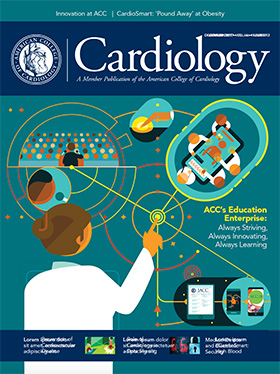JACC in a Flash
Featured topics and Editors’ Picks from all of ACC’s JACC Journals.
PRAGUE-18: No Difference in Prasugrel vs. Ticagrelor One Year After MI

The one-year outcomes of the PRAGUE-18 trial showed no difference between prasugrel and ticagrelor during the first year after an acute myocardial infarction (MI). The results were presented AHA 2017 and published in the Journal of the American College of Cardiology.
Zuzana Motovska, MD, PhD, et al., looked at 1,230 patients with acute MI treated with primary PCI and randomized to prasugrel or ticagrelor with an intent-to-treat duration of 12 months.
Results showed the endpoint of cardiovascular death, MI or stroke at one year occurred in 6.6 percent of prasugrel patients and 5.7 percent of ticagrelor patients. No significant differences were found in cardiovascular death, MI, stroke, all-cause death, definite stent thrombosis, all bleeding and thrombolysis in MI major bleeding.
Further, “economically motivated early post-discharge switches to clopidogrel were not associated with an increased risk of ischemic events.”
The authors conclude their findings “contribute to arguments in favor of the trend toward personalization of treatment of patients with acute MI.”
Motovska Z, Hlinomaz O, Kala P, et al. J Am Coll Cardiol 2017;Nov 14:[Epub ahead of print].
Study Finds Low Risk of SCA After Sex

A small percentage of sudden cardiac arrest (SCA) events are related to sexual activity, but survival rates in those cases remain low, according to research presented at AHA 2017 and published in the Journal of the American College of Cardiology. Despite these sexual activity-related SCA events being witnessed by a partner, bystander CPR was performed in only one-third of cases.
Aapo L. Aro, MD, PhD, et al., looked at the community-based Oregon Sudden Unexpected Death Study database from 2002 to 2015 to discover the frequency at which SCA occurred during or within one hour after sexual activity for all persons over the age of 18. All reported cases of SCA were based on emergency medical service reports containing detailed information regarding cause of the cardiac arrest event. Read More >>>
In total, the researchers identified 4,557 SCAs in Portland during the 13-year study period. Of these, 34 (0.7 percent) SCAs were linked to sexual activity. On average, these patients were more likely to be male, middle-aged, African-American and have a history of cardiovascular disease, with a majority taking cardiovascular medication. Patients who experienced SCA related to sexual activity also had a higher rate of ventricular fibrillation/tachycardia than those who did not. The researchers determined the low bystander CPR rate accounted for the less than 20 percent of patients who survived to hospital discharge.
Limitations to the study included unknown information surrounding the frequency of sexual activity, so researchers could not determine relative risk compared with rest and physical activity.
“Even though SCA during sexual activity was witnessed by a partner, bystander CPR was performed in only one-third of the cases,” said Sumeet Chugh, MD, senior study author. “These findings highlight the importance of continued efforts to educate the public on the importance of bystander CPR for SCA, irrespective of the circumstance.”
Aro AL, Rusinaru C, Uy-Evanado A, et al. J Am Coll Cardiol 2017;Nov 12:[Epub ahead of print].
Study Finds Poor Long-Term Outcomes Across HF Spectrum

In patients hospitalized for heart failure (HF), there are poor five-year survival rates and an elevated risk of cardiovascular and HF admission across the ejection fraction (EF) spectrum, according to research presented at AHA 2017 and published in the Journal of the American College of Cardiology.
Kevin S. Shah, MD, et al., looked at 39,982 HF patients at 254 hospitals. Patients were categorized as HF with reduced ejection fraction (HFrEF), HF with borderline ejection fraction (HFbEF) or HF with preserved ejection fraction (HFpEF).
The median survival was 2.1 years. All three groups had similar five-year mortality (HFrEF 75.3 percent, HFpEF 75.7 percent and HFbEF 75.7 percent). Cardiovascular and HF readmission rates were higher in HFrEF and HFbEF vs. HFpEF.
The authors conclude their findings “quantify the substantial burden that HF places on patients and the health care systems, irrespective of EF group, and highlight the critical need to identify new therapies that can improve outcomes for patients with HFrEF, HFbEF and HFpEF.”
Shah KS, Xu H, Matsouaka RA, et al. J Am Coll Cardiol 2017;Nov 12:[Epub ahead of print].
Better Statin Eligibility Tools Needed For Young At-Risk Persons

The majority of young adults who experience a first-time myocardial infarction (MI) may not meet statin eligibility based on current guidelines, according to the Partners YOUNG-MI Registry study presented at AHA 2017 and published in the Journal of the American College of Cardiology.
Avinainder Singh, MBBS, et al., evaluated 1,475 individuals with a median age of 45. Results show that only 724 (49 percent) and 430 (29 percent) patients would have met criteria for statin eligibility based on the 2013 ACC/AHA guideline on the treatment of blood cholesterol and the 2016 U.S. Preventive Services Task Force recommendations for statin use in primary prevention in a cohort of adults who experience a first-time MI at a young age, respectively.
Further, according to the authors, “this finding was more pronounced in women, in whom 184 (63 percent) were not eligible for statins by either guideline, compared with 549 (46 percent) of men (p < 0.001).”
The authors conclude their findings “suggest that current guidelines may fail to identify at-risk young individuals,” and that moving forward, “re-calibration of risk scores or development of novel risk scores to more accurately estimate cardiovascular risk in young adults is needed.”
Singh A, Collins BL, Gupta A, et al. J Am Coll Cardiol 2017;Nov 14:[Epub ahead of print].
Established and New Risk Scores Both Accurately Predict Subclinical Atherosclerosis

The established ideal cardiovascular health score (ICHS) and the new Fuster-BEWAT score (FBS) predict the presence and extent of subclinical atherosclerosis with similar accuracy, according to an analysis from the PESA study. The Fuster-BEWAT score does not require laboratory tests. The findings were published in the Journal of the American College of Cardiology.
Juan Miguel Fernandez-Alvira, PhD, et al., compared the established ICHS and the newly devised FBS in 3,983 asymptomatic participants without cardiovascular disease in the PESA study to determine their predictive accuracy of the presence and extent of subclinical atherosclerosis. The presence of subclinical atherosclerosis in the abdominal aorta, left carotid arteries, iliofemoral arteries and coronary arteries was determined with noninvasive vascular imaging tests. Subclinical atherosclerosis was defined as the presence of atherosclerotic plaque or coronary artery calcification score (CACS) ≥1. Read More >>>
Using both the ICHS and FBS, participants were classified as having poor, intermediate or ideal cardiovascular health. Each of the seven ICHS components (exercise, body mass index, diet, smoking status, blood pressure, serum cholesterol and fasting glucose) and five FBS components (blood pressure, exercise, weight, alimentation and tobacco) were classified as ideal or non-ideal. The participants were classified as having poor, intermediate or ideal cardiovascular health based on the total number of ideal components (ICHS: 0-2 ideal, 3-5 intermediate, 6-7 ideal; FBS: 0-1 poor, 2-3 intermediate, 4-5 ideal).
All ICHS and FBS components were ideal in 3.2 percent and 6.5 percent of participants, respectively. Most patients had intermediate cardiovascular health based on the ICHS (71.7 percent) and the FBS (61.2 percent).
A strong inverse association between ICHS and FBS classification and subclinical atherosclerosis was found. The adjusted odds ratios (ORs) for plaque presence were significantly lower among participants with scores that were intermediate or ideal vs. those with poor scores. The ORs for CACS ≥1 were significantly lower with intermediate or ideal scores vs. poor scores. Both scores were similarly associated with the extent of subclinical atherosclerosis.
Area under the curve (AUC) analyses found similar accuracy of ICHS and FBS for predicting the presence of plaque or CACS ≥1 and generalized subclinical atherosclerosis.
The results of these analyses demonstrate good and comparable predictive values with both scores for all outcomes in this cohort. “While the ICHS and the FBS show a similar predictive value for detecting subclinical disease, the FBS is simpler and does not need laboratory results. Therefore, it may be considered as a first option in settings where access to laboratory analysis is limited,” the investigators conclude.
Fernández-Alvira JM, Fuster V, Pocock S, et al. J Am Coll Cardiol 2017;70:2463-73.
Repeated ST2 Measurements Predict Adverse Outcome in Acute HF Patients

Repeated ST2 measurements, in addition to N-terminal pro–B-type natriuretic peptide (NT-proBNP) measurements, may be helpful in identifying patients with heart failure (HF) who are at increased risk of adverse outcomes, according to a study published in the Journal of the American College of Cardiology.
Using data from the TRIUMPH clinical cohort study, Laura C. van Vark, MD, et al., assessed the association of baseline and repeated biomarker ST2 measurements in patients with acute HF. ST2 is an interleukin-1 (IL-1) receptor family member with membrane-bound (ST2L) and soluble (sST2) isoforms. Read More >>>
Patients were enrolled in 14 hospitals in the Netherlands between 2009 and 2014. Blood samples were drawn during a one-year follow-up and ST2 and NT-proBNP levels were measured in a central laboratory. The primary endpoint was the composite of all-cause mortality and HF rehospitalization.
Of the 475 patients in this analysis, 37 percent were women and the median age was 74 years. The primary endpoint was reached in 188 patients (40 percent) during a median follow-up of 325 days. The median baseline ST2 level was 71 ng/ml (interquartile range, 46-102).
[R]epeated ST2 measurements are a strong and independent predictor of adverse outcomes after hospitalization for acute HF.
When adjusted for clinical factors and NT-proBNP, the baseline ST2 measurement was associated with an increased risk for the primary endpoint, with a hazard ratio (HR) of 1.30 per a one standard deviation (SD) increase of the baseline ST2 level. For repeated ST2 measurements, this HR increased to 1.85 for each SD increase in the ST2 level. The average ST2 levels appeared to increase several weeks before the primary endpoint.
“Repeated measurements take into account the dynamic and continuous change in ST2 level over time that may better reflect the true changes that occur in the underlying pathophysiological processes in the individual patient with HF,” write the authors. They conclude repeated ST2 measurements are a strong and independent predictor of adverse outcomes after hospitalization for acute HF.
van Vark LC, Lesman-Leegte I, Baart SJ, et al. J Am Coll Cardiol 2017;70:2378-88.
Keywords: ACC Publications, Cardiology Magazine, Adenosine, African Americans, Aged, Aorta, Abdominal, Area Under Curve, Atherosclerosis, Biomarkers, Blood Pressure, Body Mass Index, Body Weight, Calibration, Cardiopulmonary Resuscitation, Cardiovascular Diseases, Carotid Arteries, Cause of Death, Cholesterol, Cohort Studies, Coronary Vessels, Death, Sudden, Cardiac, Emergency Medical Services, Exercise, Fasting, Follow-Up Studies, Glucose, Heart Arrest, Heart Failure, Hospitalization, Hydroxymethylglutaryl-CoA Reductase Inhibitors, Interleukin-1, Middle Aged, Myocardial Infarction, Natriuretic Peptide, Brain, Odds Ratio, Patient Readmission, Peptide Fragments, Plaque, Atherosclerotic, Primary Prevention, Protein Isoforms, Receptors, Interleukin-1, Registries, Research Personnel, Risk Factors, Sexual Behavior, Smoking, Stents, Stroke, Stroke Volume, Survival Rate, Tachycardia, Thrombosis, Purinergic P2Y Receptor Antagonists, Ticlopidine, Tobacco, Ventricular Fibrillation
< Back to Listings

